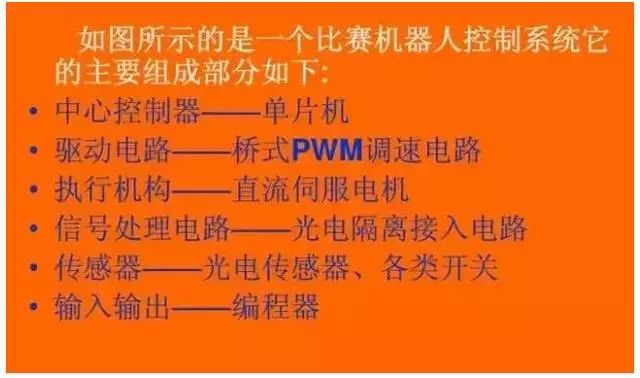
On August 26, FANUC Industrial Robot Technology Training Class
What is a Robot Control System?
If humans only had senses and muscles, their limbs would still be unable to move. This is partly because there are no organs to receive and process signals from the senses, and partly because there are no organs to send nerve signals that drive the muscles to contract or relax.
Similarly, if a robot only has sensors and actuators, the robotic arm cannot function properly. The reason is that the signals output by the sensors do not take effect, and the drive motors do not receive the necessary voltage and current. Therefore, a robot needs a controller, which consists of hardware and software to form a control system.
The function of the robot control system is to receive detection signals from the sensors and, based on the requirements of the operational tasks, drive the various motors in the robotic arm just as human activities depend on their own senses; robot motion control cannot do without sensors.


Robots need to use sensors to detect various states. The internal sensor signals of the robot are used to reflect the actual motion state of the robotic arm joints, while the external sensor signals are used to detect changes in the working environment.
Therefore, the robot’s nerves and brain must combine to form a complete robot control system.
What does the robot motion control system include?
Actuators —- Servo motors or stepper motors;
Drive mechanism —- Servo or stepper drivers;
Control mechanism —- Motion controllers, performing path and motor linkage algorithm calculations;
Control methods —- If there are fixed execution action methods, then a program with fixed parameters should be written for the motion controller; if there is a vision system or other sensors, then a program with variable parameters should be written based on the sensor signals for the motion controller.
Basic Functions of the Robot Control System
Control the motion position of the end effector of the robotic arm (i.e., control the points and paths traversed by the end effector)
Control the motion posture of the robotic arm (i.e., control the relative position of two adjacent moving components)
Control the motion speed (i.e., control the pattern of change in the position of the end effector over time)
Control the motion acceleration (i.e., control the change in speed during the motion process of the end effector)
Control the output torque of each power joint in the robotic arm (i.e., control the force exerted on the operating object)
Provide convenient human-machine interaction functions, allowing robots to complete specified tasks through memory and reproduction.
Enable the robot to have detection and sensing functions for the external environment. Industrial robots are equipped with vision, force, touch, and other sensors for measurement, recognition, and judgment of changes in operating conditions.
Industrial Robot Control System
1. Hardware Structure of the Industrial Robot Control System
The controller is the core of the robot system, and foreign companies have implemented strict blockades against our country. In recent years, with the development of microelectronics technology, the performance of microprocessors has increased while their prices have decreased. Currently, 32-bit microprocessors are available on the market for 1-2 dollars. The high cost-performance ratio of microprocessors has brought new development opportunities to robot controllers, making it possible to develop low-cost, high-performance robot controllers. To ensure that the system has sufficient computing and storage capabilities, most robot controllers currently use chips from the ARM series, DSP series, POWERPC series, Intel series, etc.
In addition, since existing general-purpose chips do not fully meet certain robot systems’ requirements in terms of price, performance, integration, and interface, there is a demand for SoC (System on Chip) technology in robot systems. This integrates specific processors with the required interfaces, simplifying the design of peripheral circuits, reducing system size, and lowering costs. For example, Actel integrates NEOS or ARM7 processor cores into its FPGA products, forming a complete SoC system. Research on robot motion controllers is mainly concentrated in the United States and Japan, with mature products such as those from DELTATAU in the USA and Yaskawa Electric Corporation in Japan. Their motion controllers are based on DSP technology and adopt an open PC-based structure.
2. Architecture of the Industrial Robot Control System
The focus of research on controller architecture is on the division of functions and the norms for information exchange between functions. In terms of open controller architecture research, there are two basic structures: one is based on hardware hierarchy, which is relatively simple. In Japan, the architecture is hardware-based; for example, Mitsubishi Heavy Industries divides its PA210 portable general-purpose intelligent robotic arm structure into five layers. The other is based on functional division, which considers both hardware and software. This is the direction of research and development for robot controller architecture.
3. Control Software Development Environment
In terms of robot software development environments, most industrial robot companies have their own independent development environments and robot programming languages, such as Japan’s Motoman, Germany’s KUKA, the USA’s Adept, and Sweden’s ABB. Many universities have conducted extensive research in robot development environments, providing a lot of open-source software that can be integrated and controlled under certain robot hardware structures. Many related experiments have been conducted in laboratory environments.
Existing robot system development environments include TeamBots v.2.0e, ARIA v.2.4.1, Player/Stage v.1.6.5.1.6.2, Pyro v.4.6.0, CARMEN v.1.1.1, MissionLab v.6.0, ADE v.1.0 beta, Miro v.CVS-March 17, 2006, MARIE v.0.4.0, FlowDesigner v.0.9.0, RobotFlow v.0.2.6, etc. From the perspective of robot industry development, there are two aspects of demand for robot software development environments. On one hand, there are demands from end users of robots, who not only use robots but also hope to program them to provide more functionalities. This programming is often achieved using visual programming languages, such as the graphical programming environment of LEGO MindStorms NXT and the visual programming environment provided by Microsoft Robotics Studio.
4. Robot-Specific Operating Systems
(1) VxWorks: VxWorks is an embedded real-time operating system (RTOS) designed and developed by Wind River in the USA in 1983. It is a key component of the Tornado embedded development environment. VxWorks has a scalable microkernel structure; efficient task management; flexible inter-task communication; microsecond-level interrupt handling; supports POSIX 1003.1b real-time extension standards; and supports various physical media and standard, complete TCP/IP network protocols.
(2) Windows CE: Windows CE has good compatibility with the Windows series, which is undoubtedly a significant advantage for its promotion. Windows CE provides a rich operating system platform for building dynamic applications and services for handheld and wireless devices. It can run on various processor architectures and is typically suitable for devices with certain limitations on memory usage.
(3) Embedded Linux: Due to its open source code, people can modify it freely to meet their own applications. Most of it adheres to the GPL, making it open source and free. It can be slightly modified for use in the user’s own system. There is a large developer community, and specialized talent is not required; anyone who understands Unix/Linux and C language can use it. It supports a vast quantity of hardware. Embedded Linux is essentially no different from regular Linux; it supports almost all hardware used on PCs. Moreover, the source code for drivers for various hardware can be obtained, greatly facilitating the writing of proprietary drivers for users’ specific hardware.
(4) μC/OS-Ⅱ: μC/OS-Ⅱ is a well-known open-source real-time kernel designed specifically for embedded applications, suitable for 8-bit, 16-bit, and 32-bit microcontrollers or digital signal processors (DSPs). Its main features include open source code, good portability, solid-state, scalability, preemptive kernel, and determinism.
(5) DSP/BIOS: DSP/BIOS is a real-time multitasking operating system kernel designed and developed by TI for its TMS320C6000, TMS320C5000, and TMS320C28x series DSP platforms. It is part of TI’s Code Composer Studio development tool. DSP/BIOS consists of three parts: a multithreaded real-time kernel; real-time analysis tools; and chip support libraries. Using a real-time operating system for program development allows for the convenient and rapid development of complex DSP programs.
5. Robot Servo Communication Bus Technology
Currently, there is no dedicated servo communication bus for robot systems internationally. In practical applications, common buses such as Ethernet, CAN, 1394, SERCOS, USB, RS-485, etc. are often used based on system requirements. Most current communication control buses can be classified into two categories: serial bus technology based on RS-485 and line driver technology, and high-speed serial bus technology based on real-time industrial Ethernet.
(1) Open and Modular Control System Architecture: It adopts a distributed CPU computer structure, divided into the Robot Controller (RC), Motion Controller (MC), opto-isolated I/O control board, sensor processing board, and programming teach pendant. The Robot Controller (RC) and the programming teach pendant communicate via serial/CAN bus. The main computer of the Robot Controller (RC) completes robot motion planning, interpolation, and position servo control, as well as main control logic, digital I/O, and sensor processing functions, while the programming teach pendant displays information and inputs commands.
(2) Modular Layered Controller Software System: The software system is built on an open-source real-time multitasking operating system, Linux, and adopts a layered and modular design to achieve openness. The entire controller software system is divided into three levels: hardware driver layer, core layer, and application layer. Each of the three levels addresses different functional requirements, corresponding to different levels of development. Each level consists of several functionally opposing modules that collaborate to achieve the functions provided by that level.
(3) Fault Diagnosis and Safety Maintenance Technology for Robots: Diagnosing robot faults through various information and performing corresponding maintenance is a key technology for ensuring robot safety.
(4) Networked Robot Controller Technology: Currently, the application engineering of robots is evolving from single robot workstations to robot production lines, making networking technology for robot controllers increasingly important. The controllers are equipped with serial, fieldbus, and Ethernet networking capabilities. This facilitates communication between robot controllers and with host computers, making it easier to monitor, diagnose, and manage robot production lines.
Disclaimer: The article comes from the internet. If there is any infringement, please leave a message or contact the editor directly for deletion.
===Learning Courses===
Recent announcements of online and offline course arrangements.
Recent recommended courses
Online and offline course announcements
The online Siemens Logo PLC training camp is now open for registration.
OnlineFANUC CNC online training camp is now open for registration.
August 21, Luoyang Siemens PLC training
August 20, Luoyang 24 Suzhou hydraulic technology training
September 22, Nanjing inverter application and common fault troubleshooting practical training class.
August 26, Luoyang multi-axis CNC processing technology and UGNX automatic programming technology training.
August 27, Beidaihe equipment inspector national vocational qualification certification.
September 16, Shanghai equipment management informationization advanced seminar.
September 14, Suzhou machine tool precision adjustment technology training class.
September 15, Beijing FANUC system CNC fault diagnosis technology training.
September 11, Suzhou machine tool assembly and PMC application training class.
September 5, Suzhou CNC FANUC driver circuit board repair training class.
September 15, Shanghai SIEMENS system programming advanced training class.
August 26, Shanghai FANUC industrial robot technology training class.
September Shanghai ABB industrial robot application technology advanced training class.
For more training content, scan the QR code below to visit the official website.
Recent announcements of online and offline course arrangements.




Welcome to scan the code to add 24-hour online customer service.


Scan the QR code to enter the online learning platform.
Enter the online learning platform from here,with many courses for you to choose from.
Morning check-in, live broadcasts, videos, training camps, etc.
Go take a look, more surprises await you~

